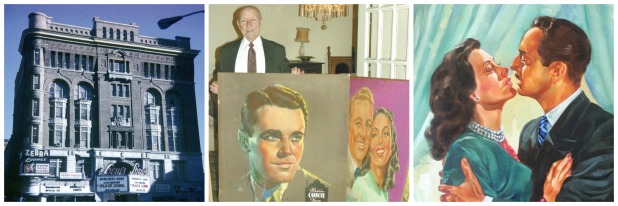A new interactive art exhibit opens this weekend at the McRitchie-Hollis Museum, 74 Jackson St.
“We’re especially proud of this exhibit and we hope a lot of people come out and see it for a glimpse of Hollywood’s golden era,” said Jeff Bishop, Newnan-Coweta Historical Society executive director.
The museum opens at 10 a.m. Saturday. A special reception honoring Mrs. Eleanor Bridges will be held at 1:30.
The new exhibit, titled “Herb Bridges’ Golden Era of Hollywood,” features about 50 hand-painted movie posters from the old Loew’s Grand Theater in downtown Atlanta.
Visitors can navigate the original works of pulp art through a special interactive booklet made especially for this exhibit, featuring QR codes connected to each painting. The codes take visitors to movie trailers and clips from the classic films that are being featured. The book also features the last published interview with local collector Herb Bridges, known worldwide for his “Gone With the Wind” collection.
Special “fun buttons” are also spread throughout the museum with sound files, music, dialogue, and excerpts from an interview with collector Herb Bridges, who collected the posters. The exhibit is made by special arrangement with Mrs. Eleanor Bridges.
Visitors can also try their hand at making their own movie poster. They are invited to either sit and color a poster indoors or use chalk on the sidewalk outside.
A small “mini-Grand” has been set up, as well, showcasing the classic black-and-white comedy, “Love Crazy,” starring Myrna Loy and William Powell. Visitors can watch the entire film as part of the exhibit.
Memories of watching films downtown on the Newnan and Grantville squares are also shared, at locations like the Gem and the Alamo.
An assortment of 1940s-era clothing is on display, as well, depicting what a typical couple from that time period would have worn to the “picture show.”
Those more interested in modern-day Hollywood can see dresses worn by Chelsea Handler and Heidi Klum, on loan from Underground Runway. The Klum dress was worn during the season finale of “America’s Next Top Model.”
The most famous article on display is the “Paris Hat” opened by Scarlett O’Hara in “Gone With the Wind.” The actual hat worn by Vivien Leigh is on display.
The pastel art “posters” on display at the McRitchie-Hollis Museum, dating from the 1920s through the 1940s, are all original works of art, made by in-house artists hired by the Loew’s Grand Theater in cinema’s early days to promote films as they were released. ‘Gone With the Wind’ famously debuted at the Loew’s Grand Dec. 15, 1939. Many other classics from the MGM glory days were shown at the Loew’s Grand as well, including “Singin’ in the Rain,” “An American in Paris, and the “Wizard of Oz.” The theatre was an Atlanta landmark for many years, until it was finally destroyed by fire in 1978. Originally an opera house, bricks from the Loew’s Grand were used to build Houston’s Restaurant on Peachtree Street in Atlanta.
Many of the posters on display were created by Sidney Smith and Charles Reese Collier, especially for the Loew’s Grand. The artists would be sent a black and white photo of a movie scene or of its stars, and they would create a painting with color which would be displayed in the window boxes as patrons entered the theater.
Although modern movie posters are mass-produced on paper, movie posters from the early years of Hollywood were made by individual theaters on wood panels. Some were textured through a process called “flocking” to give them a more detailed look. Others had three-dimensional elements, such as the scripts tacked onto the poster for the 1944 Judy Garland film, “Meet Me in St. Louis.”
For some of the three-dimensional posters, such as the 1946 Lucille Ball-John Hodiak film “Two Smart People,” the artist used several wood cut-outs that were layered on top of each other. Several other posters in the collection have the layered wood feature. Some, like the “Two Smart People” poster, used it heavily. Others used it more moderately, such as the poster for the 1937 Robert Montgomery-Rosalind Russell film, “Night Must Fall,” which is dominated by a painting of Montgomery and Russell with a small three-dimensional placard in the corner to carry the name of the film and the stars. In the poster for “Two Smart People” even the eyelashes are cut out. Sometimes the cut-outs are attached with small tacks.
There aren’t many of these specially made posters left because they were scarce to begin with. The boards they were painted on were typically recycled after about a week to make new posters. Most often posters like these were quickly discarded. The poster for the 1946 film, “Undercurrent,” which starred Katherine Hepburn, Robert Taylor and Robert Mitchum, is a great example of poster recycling. Another, unnamed movie poster can be seen on the backside.
Herb Bridges, a Sharpsburg resident who died in 2013, was an usher in the Loew’s Grand when he was a teenager. Later he was also the owner of what was perhaps the largest “Gone With the Wind” collection in the world. Bridges, an infamous “snapper-up of unconsidered trifles,” and a lifelong fan of movie memorabilia, had heard about a “mysterious stash of movie posters that had surfaced in a storage unit in Carrollton,” Georgia Public Radio reported at the time, and he just had to explore them. The seventy hand-painted posters “brought back memories of two very busy, very talented and rather abrupt artists working backstage,” he said.
Bridges said the artists not only had one week to make the posters, they also had to make multiple posters in that tight time frame. “They didn’t make one because the lobby had at least six places to show them so they’d have to make six posters at least for every movie,” he said. “On some of them, you can see the mold and they just need help, so I found this restoration lady and she took a couple and it cost $500 a piece just to get them perked up,” Bridges said in 2012.
Forty of the posters have never been displayed before, and this is the first time this collection has ever been displayed in Coweta County.
Bridges began his “Gone With the Wind” collection by collecting books and movie posters from all over the world.
“It was fun to write and try to get them,” Bridges said. “They would come through the mail. I was working at the Post Office at the time, so that was no big deal.
“I started on the movie posters. I thought, ‘What does a movie poster look like from Italy? It would look different from ours. What about one from Germany?’”
He said the “Gone With the Wind” world premiere at the Loew’s Grand was an event like none Atlanta had ever seen.
“Who knows why the book and the movie became so popular? I think it just came out, evidently, at a time when America was just ripe for that kind of story,” said Bridges.
“It just caught the American public’s imagination, and then it spread to the world. They’d had movie premieres in Atlanta before, but never like that one. Up to that time, I don’t think there had ever been as a big a premiere anywhere as big as that one. It was just such a big book, and so many copies had been sold. The public was just clamoring for it.”
Bridges said that since the movie was set in Atlanta, “it was just logical to have the premiere there.”
It was “a tremendous event,” said Bridges. “Movie stars coming to Atlanta in 1939? My gosh, that was just unheard of.”
He said people converged on downtown Atlanta from all over the country.
“Everyone wanted to see the movie stars,” said Bridges. “And of course they all wanted to see the story. We think the Olympics in Atlanta attracted a big crowd, and of course it did. But if you compare the population of Atlanta when the Olympics came through to the population of Atlanta when ‘Gone With the Wind’ was here, then proportionally the ‘Gone With the Wind’ premiere would just blow it away, with all the people who came.
“Movies were just so popular in the 30s and 40s,” Bridges said. “It was a big, glamorous event, with all the high society and all the parties and all the junk that was sold. They were smart. They sold all kinds of stuff.”
He said candy boxes, perfume, dresses, and scarves were all popular.
“They sold everything ‘Gone With the Wind’ that you can imagine,” said Bridges.
The Thirties “just has that look,” he said, and movie posters from that era are very collectible today.
“Movie posters came into vogue as collectibles in the 70s,” he said.
“People began to collect old movie posters, and the ‘Gone With the Wind’ posters were always valuable,” he said. “They still are.”
Only two or three movies from the Golden Era still hold their value, when it comes to collectibles like posters, Bridges said. The main ones include “Wizard of Oz,” “Citizen Kane,” “Casablanca,” and, of course, “Gone With the Wind.”
“If you can get a hold of any of those original movie posters, you are going to pay thousands of dollars for it,” he said. “It was a limited kind of market.”
He said that the poster market these days is completely different, since art is so easily reproduced.
“You’ve got all this new, modern equipment now, which can reproduce things so easily, so you have to be very careful,” said Bridges. “Like in Underground Atlanta they used to have little poster shops. They would sell reproductions for teenagers to collect. You have to be very careful. You wouldn’t pay $2,000 or $3,000 for a poster that was produced in 1986.
“And the movie collectors, they know,” Bridges said. “There are ways to find out the real value of posters. The old ones are still very valuable. And you can find some in flea markets, still. I would hunt for those in Atlanta. That’s the only place I went. I didn’t go all over the country. And there weren’t even that many flea markets back then, to tell you the truth.”
Bridges said he used to look forward to a publication called “The Antique Trader.”
“It came out every week,” he said. “You could advertise in there. If you wanted to sell something or buy something, it was usually in there.”
Tickets are $5 for adults and $2 for seniors and students. Hours are Tuesday-Saturday, 10 a.m.-noon and 1-3 p.m. The museum is located at 74 Jackson St., beside the new University of West Georgia campus.
*











Leave a Comment
You must be logged in to post a comment.